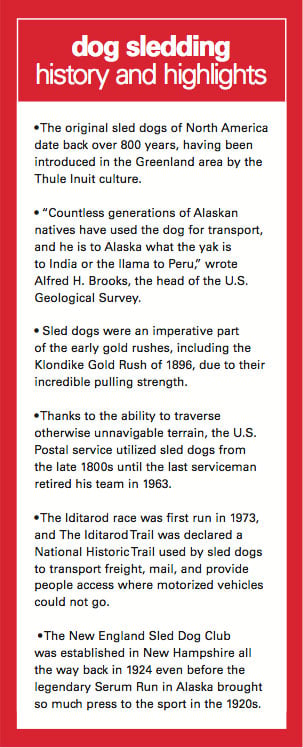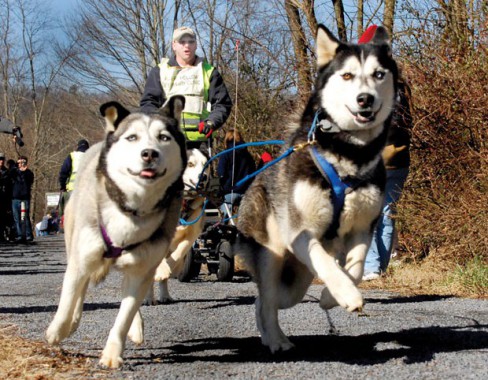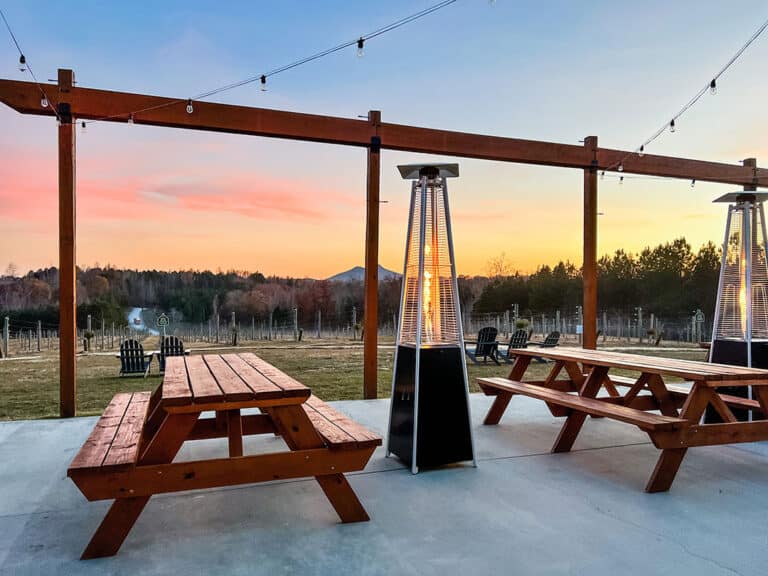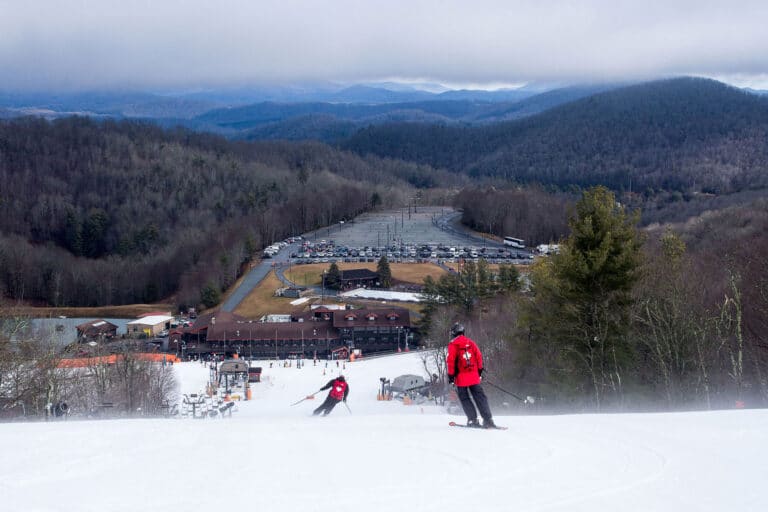Photo: Earl Neikirk
In January of 2011, teams of sled dogs and mushers relayed down the 16-mile stretch of the Virginia Creeper Trail from Abington to Damascus relaying fake serum. They were paying respect to the legendary Alaskan Serum Run of 1925 during which mushers navigated nearly 700 miles of the wild Alaskan wilderness, relaying a serum to stop the imminent diphtheria epidemic that was breaking out amongst villagers and surrounding native communities back in Nome. Although the Virginia re-enactment was a far cry from Alaska, it was one of the largest dog sledding events ever in the South—and it actually snowed on race day.
“That was the only time I have run sled dogs in the snow in the South,” 2008 Iditarod Contender Rodney Whaley recalled.
Each team ran a four-mile segment of the relay and hundreds of people were there to watch at every stop as southerners ran with traditional snow sleds through the white blanket covering the trail. They made history that day, a history that even made Alaskan newspapers.
“Virginia re-enactment of Alaskan serum run gets a rare treat: snow,” read the headline of the Alaskan Dispatch.
Virginia rarely receives enough low-elevation snowfall throughout the year for snow racing, but that doesn’t stop mushers or their dogs from adapting and innovating the classic adventure sport; a sport that seems to be as popular amongst the animals as the humans who train them.
“Those dogs were designed to see the wilderness,” said Bill Borden, the only Georgian to ever complete the legendary Iditarod race, which he ran in 2002. “When those dogs turn a corner and get onto a new trail, they just get a burst of life—they’re looking for the next adventure around the next corner.”
Many people don’t understand the complexities of breeding dogs and assume that a dog is just, well, a dog and in turn that it’s cruel to make them pull a heavy sled. But every dog breed was created with some purpose in mind, and the history of sled dog breeds is a long one. Today the most common breeds are the Siberian and Alaskan huskies and Alaskan malamutes, but they stem from a heritage that some sources date back to 4,000 years ago. All of these dogs were bred for their incredible strength, high energy, outstanding endurance, and tolerance of icy cold weather. They were bred as cold-weather working dogs.
Because of that disposition, many of these breeds have a lot of pent-up energy to expel and if it isn’t let loose, they can become restless, anxious, and sometimes destructive. A simple walk isn’t likely to cut it for them and sadly is exactly the reason that many of these dogs are abandoned.
“That’s part of the education of dogsledding: a dog that is a working-breed dog requires something besides take it for a walk. A happy husky is a tired husky,” says Marcia Horne, head of the Virginia-based not-for-profit Siberian Husky Assist Rescue Center.
Many dogs are taken out on the trail where they can be in the wilderness and let off some steam. Watch any mushing team prepare for a run and you’ll see they literally light up, yipping, barking, and bouncing around with excitement once the harnesses get put on them. They simply don’t want to wait any longer to pull and go. And that’s what they do. They just go, because they were built to do it.
THE BIRTH OF A COMMUNITY
 Less than a decade ago, Marcia and her husband Bob adopted their first Siberian husky from a rescue shelter. Having learned a lot about the breed and been interested in its history as a working dog, they began to explore dog sledding. Not long after they decided to do two more things. Open their own Siberian husky rescue shelter and start educating other people about mushing in The South.
Less than a decade ago, Marcia and her husband Bob adopted their first Siberian husky from a rescue shelter. Having learned a lot about the breed and been interested in its history as a working dog, they began to explore dog sledding. Not long after they decided to do two more things. Open their own Siberian husky rescue shelter and start educating other people about mushing in The South.
“When we did our first event in January of 2004, we advertised that we were going to let people bring their huskies or their high-energy dogs, and we were going to let their dogs pull the sled with our dogs,” Marcia said.
The turnout was huge. About three-and-a-half hours into the event, Marcia and Bob had harnessed up dogs, 50 of them being Huskies. Not long after, Marcia met with fellow enthusiasts from as far away as Minnesota and began teaching more classes to eager dog owners—and sometimes even their children—who would bring their dogs to team up with a four-to-six-dog team to pull a sled.
They made the leap to go further. With the support of enthusiastic members such as Rodney and his mushing pal Jeff Blewett of Kentucky, the Blue Ridge Dryland Sled Dog Club was created within the Rescue Center. It wasn’t long before mushing enthusiasts joined from Maryland, Kentucky, Georgia, Virginia, North Carolina, South Carolina, Tennessee, and even Alabama.
A sled dog community in the Southern Appalachians had been connected and established. It continues to grow as a handful of role models for the sport, such as Rodney or Bill Borden (who started the Cool Dreams Foundation which teaches Iditarod-based programs to children all over the country), teach young scout troops, school children, and other future mushers.
TRAINING FOR ADVENTURE
It doesn’t seem to be the least bit coincidental that the Iditarod continues to come up in regular conversation with most any mushing enthusiast. The Iditarod is like the Holy Grail of the sport, and with good reason. Billed as “The Last Great Race”, the 1,049-mile race across desolate Alaskan landscapes fuels inspiration for mushers, spectators, and admirers worldwide.
“I’m 59 years old, so I guess 50 years ago I was nine years old when I ran my first race. Me, a little sled, and one dog. Half a mile,” Rodney recalls his childhood growing up in Alaska. “Of course I’d watched the big races like the Iditarod, I’d go down to 4th avenue and it’d be on television and all that. As a little kid I fantasized of doing that someday. That was my dream.”
Rodney was the only Tennessean to ever contend in the race and one of just a couple others in the entire South.
The urge to compete or even just push the sport to be more adventurous is driven by other big adventure races aside from just the Iditarod, such as the 1000-mile international Yukon Quest race (spanning the gap between Fairbanks, Alaska and Whitehorse, Yukon), the 400-mile John Beargrease race in Northern Minnesota, the Big Sky in Montana, the UP 200 in Michigan, the Alpirod in Europe, and even just personal adventures taken in snowy, remote locations across the Northern U.S and Canada.
But the adventure starts at home.
Guys like Rodney and Jeff, who are always interested in pursuing further adventures in the snowy North, take their dogs on multi-day mushing and camping trips in the South to build their endurance. Of course, these trips are a little different in the South than in the snowy North.
Down in these parts mushers use dryland rigs, which refers to any wheeled craft built to be pulled by dogs. A standard rig can range from different configurations like a two-wheeled scooter, to what looks like a grown-up’s tricycle without pedals, to a rig that is essentially a snow sled but with wheels.
Surprisingly enough, pulling these wheeled rigs is often tougher than pulling a snowbound sled. Many of the snow-less trails that are used for dryland running in the South have rough terrain and rough gravel as opposed to snow or even just crushed limestone, which is easier on the dogs’ feet. And even when the trails do have a little bit of snow, the wheels on dryland rigs often get more bogged down than a sled’s runners would, creating stronger resistance against the dogs.
The catch is that some of these factors can actually give the dogs a bit of an advantage over northern dogs that train mostly in snow. Huskies and malamutes are surprisingly versatile and have the ability to slowly acclimate to warmer temps. When the southern dogs take to the comfortable cold and slicker snow, they find it easier than the warmer 30 to 40 degree temps and gravel they’re often used to, while Northern dogs find those temperatures discomforting if temperatures rise during a race, which sometimes even happens during the Iditarod.
“The rule of thumb is, you run a mile per dog. In other words, if I take a four-dog team out, about four miles is what I want to run,” says Jeff. “If you run four miles on dry land, you can automatically double that when you get to snow. Dryland is tougher, it’s harder, there’s so much more impact, and there’s so much more resistance as far as pulling a sled on snow or a cart with wheels.”
TRAILBLAZING
Some of the best places for mushing are rails-to-trails projects, thanks to their smooth, long, flat nature. The 184-mile C&O Canal running from D.C. to Cumberland, Md. has seen enthusiastic mushers as well as snow to mush in, along with the Virginia Creeper Trail.
“Hands down, my favorite place in that region is the Creeper Trail. The scenery is beautiful, the people there are so nice… if I didn’t live in Kentucky, I’d live in Virginia,” Jeff says, recalling the numerous races he has participated in there.
Others improvise using roads that are commonly shut down when winter strikes, serving as beautiful, perfect locales for mushing, such as the Blue Ridge Parkway.
But perhaps one of the most exciting and progressive events taking place in the South this year is the Land Between the Lakes Sled Dog Dash taking place in Kentucky, nestled on the Kentucky/Tennessee border at the Land Between the Lakes National Recreation Area which has over 200 miles of gravel roads that can be used for training.
“A lot of us have aspirations to run some of those bigger races in a format like this one that we’re doing. It will give you a chance to overnight with your dogs, camp out on the trail if you want to, pay attention to their health and their welfare, so it kind of trains you in a lot of ways to get ready for some of those bigger races,” says race coordinator Jeff Blewett.
While the Land Between the Lakes Dash and other similar races are more what you might consider “fun runs” when compared to the bigger, longer races of the North, the race has caught the attention of a potential huge sponsor considering sanctioning the event and possibly spreading it to surrounding states, which could further change the future of adventure mushing in the South.
Let’s just put it this way: snow, trails, speed, sleds, dogs, camping, wilderness… it’s kind of exciting.
“It’s nothing you can really articulate to anybody. It’s just a really different way to enjoy the wilderness,” Blewett says.
And nobody loves it more than the dogs themselves.








